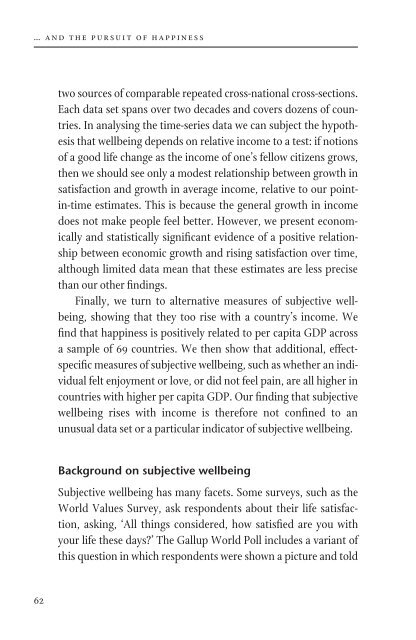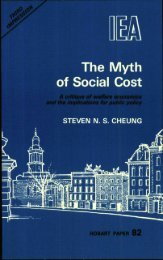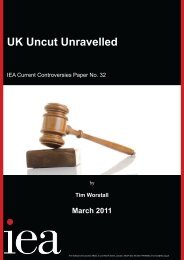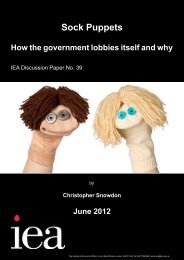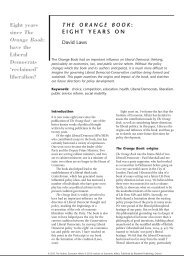… and the Pursuit of Happiness - Institute of Economic Affairs
… and the Pursuit of Happiness - Institute of Economic Affairs
… and the Pursuit of Happiness - Institute of Economic Affairs
Create successful ePaper yourself
Turn your PDF publications into a flip-book with our unique Google optimized e-Paper software.
<strong>…</strong> <strong>and</strong> <strong>the</strong> pursuit <strong>of</strong> happiness<br />
subjective wellbeing<br />
two sources <strong>of</strong> comparable repeated cross-national cross-sections.<br />
Each data set spans over two decades <strong>and</strong> covers dozens <strong>of</strong> countries.<br />
In analysing <strong>the</strong> time-series data we can subject <strong>the</strong> hypo<strong>the</strong>sis<br />
that wellbeing depends on relative income to a test: if notions<br />
<strong>of</strong> a good life change as <strong>the</strong> income <strong>of</strong> one’s fellow citizens grows,<br />
<strong>the</strong>n we should see only a modest relationship between growth in<br />
satisfaction <strong>and</strong> growth in average income, relative to our pointin-time<br />
estimates. This is because <strong>the</strong> general growth in income<br />
does not make people feel better. However, we present economically<br />
<strong>and</strong> statistically significant evidence <strong>of</strong> a positive relationship<br />
between economic growth <strong>and</strong> rising satisfaction over time,<br />
although limited data mean that <strong>the</strong>se estimates are less precise<br />
than our o<strong>the</strong>r findings.<br />
Finally, we turn to alternative measures <strong>of</strong> subjective wellbeing,<br />
showing that <strong>the</strong>y too rise with a country’s income. We<br />
find that happiness is positively related to per capita GDP across<br />
a sample <strong>of</strong> 69 countries. We <strong>the</strong>n show that additional, effectspecific<br />
measures <strong>of</strong> subjective wellbeing, such as whe<strong>the</strong>r an individual<br />
felt enjoyment or love, or did not feel pain, are all higher in<br />
countries with higher per capita GDP. Our finding that sub jective<br />
wellbeing rises with income is <strong>the</strong>refore not confined to an<br />
unusual data set or a particular indicator <strong>of</strong> subjective wellbeing.<br />
Background on subjective wellbeing<br />
Subjective wellbeing has many facets. Some surveys, such as <strong>the</strong><br />
World Values Survey, ask respondents about <strong>the</strong>ir life satisfaction,<br />
asking, ‘All things considered, how satisfied are you with<br />
your life <strong>the</strong>se days?’ The Gallup World Poll includes a variant <strong>of</strong><br />
this question in which respondents were shown a picture <strong>and</strong> told<br />
‘Here is a ladder representing <strong>the</strong> “ladder <strong>of</strong> life.” Let’s suppose <strong>the</strong><br />
top <strong>of</strong> <strong>the</strong> ladder represents <strong>the</strong> best possible life for you; <strong>and</strong> <strong>the</strong><br />
bottom, <strong>the</strong> worst possible life for you. On which step [between<br />
0 <strong>and</strong> 10] <strong>of</strong> <strong>the</strong> ladder do you feel you personally st<strong>and</strong> at <strong>the</strong><br />
present time?’ This question, which we refer to as <strong>the</strong> satisfaction<br />
ladder, is a form <strong>of</strong> Cantril’s ‘Self-Anchoring Striving Scale’<br />
(Cantril, 1965). O<strong>the</strong>r surveys ask about happiness directly. Gallup<br />
also asks a battery <strong>of</strong> more specific questions, ranging from ‘Were<br />
you proud <strong>of</strong> something you did yesterday?’ to ‘Did you experience<br />
a lot <strong>of</strong> pain yesterday?’ Whereas <strong>the</strong> satisfaction question invites<br />
subjects to assess <strong>the</strong> entirety <strong>of</strong> <strong>the</strong>ir wellbeing, <strong>the</strong> more specific<br />
questions measure feelings ra<strong>the</strong>r than assessments (Diener,<br />
2006). In this chapter, we largely focus on life satisfaction.<br />
We do this for two reasons. First, we would like to use as many<br />
data sets as possible to assess <strong>the</strong> relationship between subjective<br />
wellbeing <strong>and</strong> income. It is <strong>the</strong> case that income <strong>and</strong> life satisfaction<br />
<strong>and</strong> <strong>the</strong> satisfaction ladder are more commonly measured<br />
than any o<strong>the</strong>r measure. Secondly, <strong>the</strong> previous literature documenting<br />
<strong>the</strong> Easterlin paradox (including Easterlin 1974, 1995,<br />
2005a, 2005b, 2009) has largely focused on life-satisfaction questions<br />
(even though researchers have tended to label <strong>the</strong>se analyses<br />
<strong>of</strong> ‘happiness’). As noted above, we do <strong>the</strong>n look at o<strong>the</strong>r measures<br />
<strong>of</strong> wellbeing <strong>and</strong> find <strong>the</strong> results are similar to <strong>the</strong> income–satisfaction<br />
link.<br />
Subjective wellbeing data are useful only if <strong>the</strong> questions<br />
succeed in measuring what <strong>the</strong>y intend to measure. Economists<br />
have traditionally been sceptical <strong>of</strong> subjective data because <strong>the</strong>y<br />
lack any objective anchor <strong>and</strong> because some types <strong>of</strong> subject ive<br />
data suffer from severe biases (e.g. Diamond <strong>and</strong> Hausman,<br />
1994). These objections apply to subjective wellbeing data, but a<br />
62 63


